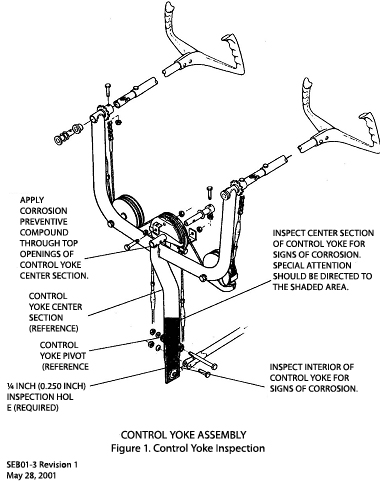AL 2009-07R1
15 January 2010
A recent SDR reported that the control yoke (see diagram) on a parked aircraft broke during high ground-wind conditions. Further investigation of the yoke assembly revealed that a complete fracture had occurred between the yoke pivot area and the elevator attachment point. It was determined that the yoke fracture was due to severe internal corrosion. It is important to note that had the fracture occurred in flight, it would have resulted in a complete loss of elevator (primary pitch) authority. A complete fracture above the pivot point would have resulted in a loss of both the aileron (roll) and elevator (pitch) control authority.
Several years prior to this event; Cessna issued Service Bulletin (SB) SEB01-3 Revision 1, dated 28 May 2001. The SB provides instructions for the removal and drilling of an inspection hole at the yoke base, and the application of corrosion treatment. SEB01-3 also recommends that repeat internal and external yoke inspections, in conjunction with corrosion treatment, be carried out each following year.
In this recent case, the operator had not complied with the manufacturer’s SB SEB01-3.
Additionally, while complying with SB SEB01-3 Revision 1, a foreign operator found water when the inspection hole was drilled at the yoke base. A quarter of a cup of water and black corrosion residue was drained from the lower area of the yoke tube. Significant rust and corrosion was found inside the full length of the centre tube. In another unrelated case, while complying with SB SEB01-3, the required inspection hole was drilled too large and it was mislocated. This error weakened the structural integrity of the yoke and later resulted in a complete fracture of the yoke.
The FAA previously published a Special Airworthiness Information Bulletin (SAIB) CE-04-03 (in year 2003) on this same subject, strongly advising that operators comply with Cessna SB SEB01-3 and treat the control yoke with corrosion preventative at the earliest opportunity.
Transport Canada Civil Aviation (TCCA) strongly encourages owners, operators and other agencies to comply with the instructions contained within Cessna SB SEB01-3 Revision 1. Please note that the effectivity of the SB covers all the aircraft that have reported this widespread problem. A service history review has determined that this problem is not limited to a specific model year, geographical location or hours of operation that would make one aircraft’s yoke more susceptible to having corrosion than any other models. The only definitive way to determine the internal condition of the yoke tube is to comply with the aforementioned SB.
Defects, malfunctions and failures occurring on aeronautical products should be reported to Transport Canada, Continuing Airworthiness in accordance with CAR 521 mandatory Service Difficulty Reporting requirements.
For further information, please contact a Transport Canada Centre, or Mr. Barry Caldwell at 613-952-4357 or email mailto:CAWWEBFeedback@tc.gc.ca or any Transport Canada Centre.
For Director, National Aircraft Certification
ORIGINAL SIGNED BY
Philip Tang for
Derek Ferguson
Chief, Continuing Airworthiness
Note: For the electronic version of this document, please consult the following Web address: https://tc.canada.ca/en/aviation/aircraft-airworthiness/aircraft-certification
